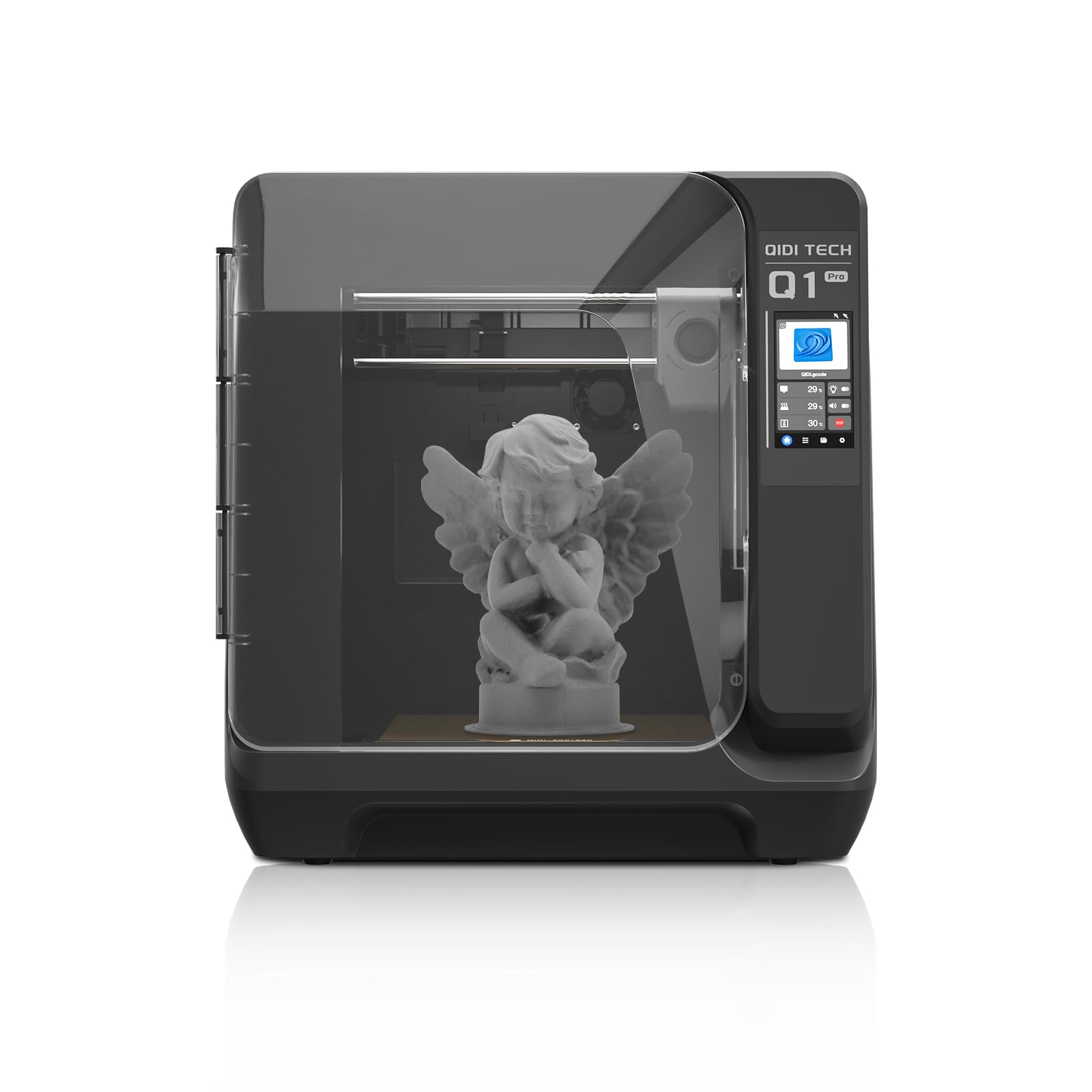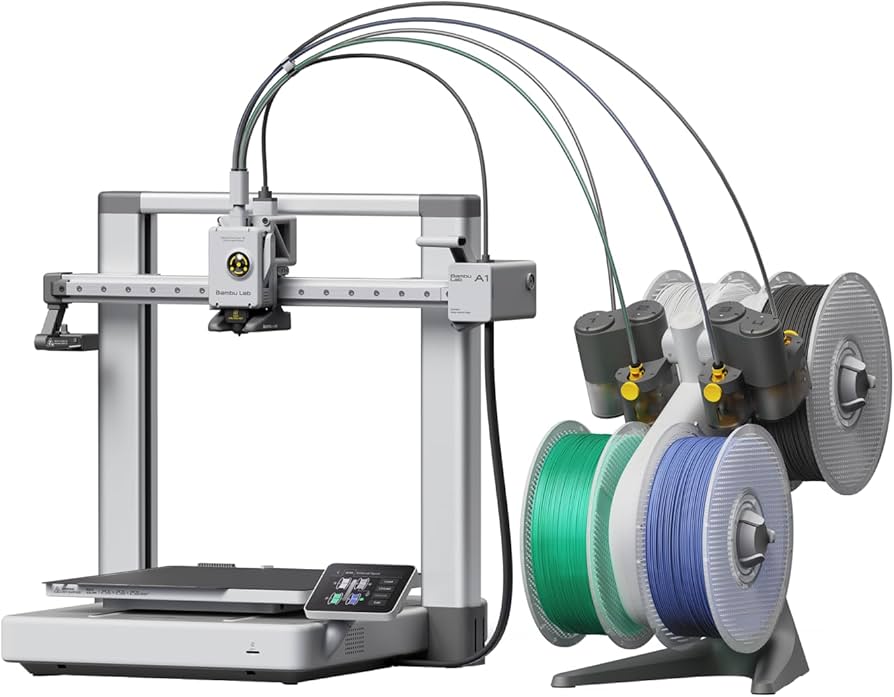Compare Q1 PRO vs A1
Comparison between the best 3D printers
Choose the best 3D printer at the best price. The cheapest 3D printers are here.
Buy a 3D printer here with 3D Fila.
 |
 |
|
| Model | Q1 PRO[BUY Q1 PRO] |
A1[BUY A1] |
| Printing Material | Filament | Filament |
| Buy Filament for QIDI Q1 PRO | Buy Filament forBambu Lab A1 | |
| Estimated price | $449,00 | $700,00 |
| Manufacturer | QIDI | Bambu Lab |
| Release Year | 2024 | 2023 |
| Print Volume [mm] | 245x245x245 | 256x256x256 |
| Printer Size [mm] | 467x477x489 | 385x410x430 |
| Weight [kg] | 20 | 8,3 |
| Power Loss Recovery | YES | YES |
| Enclosed printer | YES | NO |
| Bed Leveling | Automatic | Automatic |
| Filament End Sensor | YES | YES |
| Bed type | Heated | Heated |
| Power supply system | Direct Drive | Direct Drive |
| Standard nozzle | 0,4 | 0,4 |
| Maximum Nozzle Temperature [°C] | 350 | 300 |
| Maximum Bed Temperature [°C] | 120 | 100 |
| Maximum printing speed [mm/s] | 600 | 500 |
| Filament holder | YES | YES |
| Camera for supervision | YES | YES |
| Recommended filaments | PLA、ABS、ASA、PETG、TPU、PC、PA、PA-CF、PET-CF、PAHT-CF etc. | PLA, PETG, TPU, PVA |
| Recommended slicers | QIDI Slicer/Cura/Simplify 3D/ORCA/PRUSA Slicer | SuperSlicer, PrusaSlicer, Cura, OrcaSlicer |
| Maximum Resolution [mm] | 0,1 | 0,1 |
| Processor | Cortex-A53,64-bit Processor | |
| Display | Touchscreen 4,3'' | Touchscreen 3,5 |
| Power Supply | 350 W | 350 W |
| Connectivity | WiFi/USB Flash Drive/Ethernet Cable | Wi-Fi, Bambu-Bus, Cartão Micro SD |
| Operating systems | Windows, Linux, Macbook | Windows, Linux, Macbook |
| Date of registration in the system | 2024-07-09 | 2024-07-17 |
| Release date | 2024 | 2023 |
| Extra features | The QIDI Q1 Pro 3D printer stands out for its Core XY structure and heating chambers that reach up to 60ºC, ideal for advanced materials such as ABS and Nylon. It features Klipper firmware, an automatic leveling system, a high-flow extruder with a double metal nozzle and a hotend that reaches 350ºC. It offers connectivity via Wi-Fi, USB and Ethernet, as well as a 1080p camera for remote monitoring and an intuitive touchscreen for easy operation. | The BambuLab A1 printer features fully automatic calibration, multi-color printing with the AMS system, active flow rate compensation, quick nozzle change with a clip, active motor noise cancellation, a build volume of 256x256x256 mm³, a maximum extruder temperature of 300°C, and a heated bed of up to 100°C. In addition, it has high precision, a machine health management system and an intuitive 3.5-inch touchscreen interface. |
| Support for multiple colors and materials (AMS and CFS) | NO | YES |
Notes * |
||
| Cost-benefit | 8 / 10 | 7 / 10 |
| Hardware | 5.4 / 10 | 4.8 / 10 |
| Tela | . | . |
| Print volume | 3 / 10 | 4 / 10 |
| Performance | 5 / 10 | 4 / 10 |
| [BUY Q1 PRO] | [BUY A1] |
Conclusion |
| In comparing the QIDI Q1 Pro and the Bambu Lab A1, both printers showcase strong features appealing to different user needs. The QIDI Q1 Pro emerges as a robust choice with its larger print volume and capability to handle advanced materials due to its higher maximum nozzle and bed temperatures. Its enclosed design, automatic leveling, and extensive compatibility with various filaments further enhance its versatility, making it a solid option for those looking to experiment with different materials. On the other hand, the Bambu Lab A1 offers unique features such as multi-color printing capabilities and active flow rate compensation, which may attract users interested in intricate designs with color variations. Its lightweight build and intuitive interface make it user-friendly, while its slightly smaller print volume and lower temperature specifications may limit some advanced printing applications. From a pricing perspective, the QIDI Q1 Pro is notably more economical, offering great value for its expanded features and capabilities. In contrast, the Bambu Lab A1, though priced higher, compensates with advanced technology focusing on ease of use and innovation. Ultimately, the choice between these two printers may boil down to specific needs: if a user seeks versatility and the ability to work with various advanced materials at a lower price, the QIDI Q1 Pro is the way to go. Conversely, those prioritizing innovative features and ease of use may find the Bambu Lab A1 a worthwhile investment despite its higher cost. Both models feature strong performance ratings, ensuring users are likely to be satisfied with their 3D printing experience regardless of their choice. |

